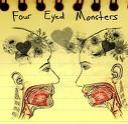Swarm of Angels & Four Eyed Monsters
 Filmmakers are in general quite conservative. Their love for high quality image, 16 mm, 35 mm, big screenings and Hollywood attraction is usually overshadowing the curiosity for developments in the area of new media. This is a shame, especially because new media techniques involve a whole new way of filmmaking, avoiding top-down approach of production and enhances freedom of choice on subjects. There are though at the moment some interesting experiments going on. The first project I want to mention is Swarm of Angles.
Filmmakers are in general quite conservative. Their love for high quality image, 16 mm, 35 mm, big screenings and Hollywood attraction is usually overshadowing the curiosity for developments in the area of new media. This is a shame, especially because new media techniques involve a whole new way of filmmaking, avoiding top-down approach of production and enhances freedom of choice on subjects. There are though at the moment some interesting experiments going on. The first project I want to mention is Swarm of Angles.
Swarm of angles is the first open source film project. It is funded, crewed and distributed completely on the Internet and the idea is to find 50.000 individual subscribers (The swarm) each contributing £25 to the production.
The general idea is, that every subscriber can be part of the decision-making process or even be artistically involved when ‘enough talented and skilled’. Matt Hanson is the initiator of this project. He is founder of the Onedotzero Film Festival and filmmaker and author. He has labeled this project the first Cinema 2.0.
This project is a short cut for me to make a feature film, but also a way to redefine filmmaking methods, and legitimize a whole new model of making ‘bigger media’ that will work for a new generation of content creators. This type of participate content is the missing link between the top-down approach of traditional media creation and the bottom-up nature of user-generated content.
The system used for producing the film is in short:
1. Fund the project. Call for collaborators. Publicize and create marketing materials. Gather the first 1000 members through targeting niche online communities and parts of the blogosphere. Develop the project and infrastructure. Start script development. Open the project up to more members.
2. Film. Collaborate. Develop scripts using a ‘wiki‘. Crew through The Swarm. Funding drive for pre-production/production/post-production. Create marketing and final materials.
3. Flow. Master materials. Create spin-off materials. Publicize. Burn. Upload. Seed. Download. View. Remix. Share.
At the moment two scripts are being developed: The Unfold and Glitch. One will be chosen by ASOA members to be produced. According to the official website, A Swarm of Angels is likely to be thriller based with soft sci-fi elements. The scripts are being developed via the project forum The Nine Orders. Here members can keep themselves posted about current developments on production and scripting and votings takes place here too.
Swarm of Angels wants to use the increasing power of the blogosphere and the social Internet to engender mass collaborations and promote Creative Common’s copywrite. They want to create a new model filmmaking where there is no need for copy protection and the distribution will be by bittorrents and podcasts. Swarm of Angels is a non-profit project. Once the film is finished, it will be distributed for free on the Internet. Members have already agreed that any excess profit made, will be used for developing a next project.
Nice thought, only, the Swarm of Angels do not answer the question how the participating filmmakers should pay their rent while working on the film. Does filmmaking has to become even more a hobby than it sometimes already seems to be?
Another question is, if it is possible to create an interesting film out of a democratic process. Probably not. 50.000 people voting on script decisions can hardly develop any consistent artistic vision. But this is not the issue here, I suppose. The film created will be ready for remixing, free to be used for everyone. This new way of –remixing cinema- filmmaking is definitely getting done with the role of ‘the author’ as the almighty father of the story. Power is giving to the DIY user who can take the film to pimp up his online profile or use it any way he likes. In this case, there is still an almighty father namely Matt Hanson, who did set the rules in the first place and will probably do so again if things were going the wrong direction.
By the way, subscription is closed right now, end of phase two is achieved, 1000 angles are already in. the only way to get in now, is by personal invitation only. For the rest of us, we have to wait till the next phase. Interesting marketing strategy? Or is it just because the crew is taking a break…

A totally different 2.0 cinema project is Four Eyed Monsters. This project is made by Susan Buice and Arin Crumley and was entirely financed by multiple creditcardcompanies.
While working on the film, they were showing episodes on Myspace TV and eventually they showed the whole film online for free on YouTube and Myspace. All together, they were in debt, according to the website www.foureyedmonsters.com for a 100.000 dollars. Now they use the Internet as a fundraising system afterwards by raising a community. One thing really did get them going was a contract with http://www.spout.com/foureyedmonsters. For every subscriber on sprout, they receive 1 dollar. The counter is right now already on 47,104 subscribers and their first 3 creditcards could be destroyed (what was filmed and posted as well off course).
Another way the filmmakers are giving publicity to their film is the way they encourage users to request a screening, and if enough people in a particular place requested the film the producers organized a screening. They even held a screenings in New Yord and yes offcourse in Second Life too.
They encourage videobloggers to respond on their film too, to build an even bigger community of interest around the film.
Interesting is the link on their website to http://bravenewtheaters.com/. This is an initiative where any independent filmmaker can send in their film in search for little theatres, sometimes with just one chair (!) to screen their films. Also anybody can subscribe himself as being a host for new films. I am not sure until what extend this system is already working, but the concept is certainly charming.
In short you could say that Susan and Arin are using the new media circus very well. Just as in the music industry they use their finished product to generate money on an alternative way by offer it directly to its audience, without intervention of broadcasters or studio’s. For the content of the film itself this seems not to make a big difference. It’s a lowbudget adolescent lovestory, made by two independent, narcistic, talented and inventive young people. Interesting is the way the film is continuing in order to create more income. The difference between their real lives and their film persona’s are blurring, and they keep recording and publishing small things of their lives to keep the community alert and interested.
The big difference between the Swarm of Angles project and Four Eyed Monsters is that besides the latter is actually finished before the audience gets involved, they do sell DVD copy’s in order to pay they creditcard debts. Their audience is just participanting in the distribution part, and not in the creation part. It mainly functions as some sort of a marketing tool towards other company’s while the couple is getting famous: Youtube eyeballs increasing, screenings on big festivals, invitations to debates on new media developments and reviews in the New York Post. They did well.
What can we say in general about this so-called cinema 2.0 besides the democratic possiblities? In the first place it seems to be about generating money, without having the censorship of big studio’s and broadcasters. It gives direct access to a huge amount of people. This way of producing is partly possible because of the material: cheap digital camera’s with a considerable high quality, desktop editing and easy uploading and distributing on the web makes it for almost every individual with the right drive possible to become a filmmaker. Fundraising online is proven to be a way to find money and to make unexpected and interesting cooperations.
I am curieus though, what kind of influence it has on the content of the films itself. Are we still going to watch more and more Si-Fi films and love stories, or will the message of the medium eventually change by its applications.



